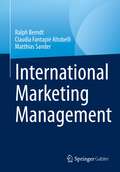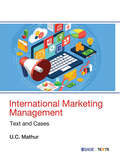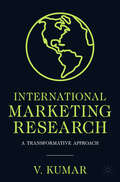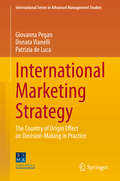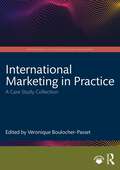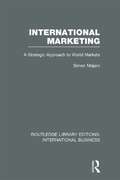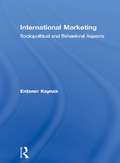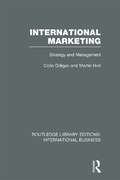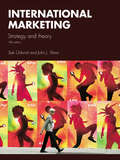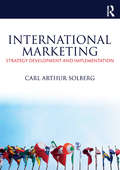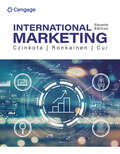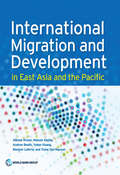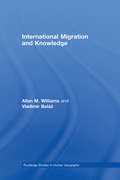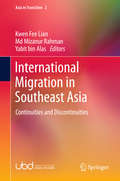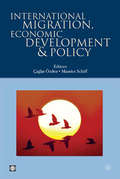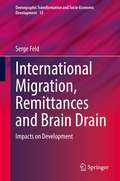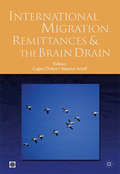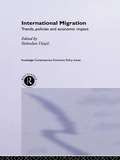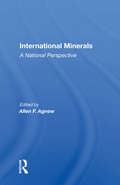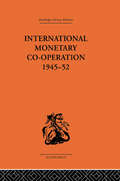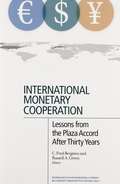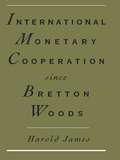- Table View
- List View
International Marketing Management
by Ralph Berndt Matthias Sander Claudia Fantapié AltobelliFor every company that is active internationally, a systematically operated cross-national marketing management is indispensable in order to secure its own existence in the long term. The rapid changes on many markets and in many countries also mean that professional information gathering and processing of market-relevant data must take place within the framework of international market research. Based on this data, market-oriented decisions have to be made within international marketing management in order to achieve operational goals. This book deals not only with the "classic" topics of international marketing, such as international market research and the international use of individual marketing instruments, but also with the various management sub-functions of planning, controlling, organization and human resources management in internationally active companies, each with a specific reference to marketing in the sense of market-oriented corporate management. The theoretically presented correlations are enriched by current data on the relevant framework conditions on international markets, empirical findings on the individual fields of action of international marketing management as well as numerous current examples from entrepreneurial practice. With this comprehensive presentation of international marketing management, the authors address lecturers and students as well as practitioners who deal with marketing issues in an international context.
International Marketing Management: Text and Cases (SAGE Texts)
by U C MathurGiven the need for Indian managers to be fully aware of the issues related to International Marketing, this has emerged as a major study area over the last few years. It constitutes an integral part of the syllabi in most reputed business schools. International Marketing Management: Text and Cases attempts to make learning the nuances of the subject easy from the students` viewpoint. Some of its key features are: - An analysis of international trade, economic free trade zones, embargoes on exports, and the tariff and non-tariff barriers that companies face - The role of international organisations under the aegis of the United Nations in international marketing - The systems and the forms used in international marketing in India - A focus on the importance of stakeholders of a company for corporate survival - Highly developed and class-tested management games The interactive management games and carefully selected case studies provide hands-on corporate experience to students, making the book invaluable for those pursuing MBA, BBA and MIB programmes. It would also be of interest to corporate marketing heads and others in the field of marketing.
International Marketing Research: A Transformative Approach
by V. KumarThis book provides a practical, detailed, and well-documented guide that takes students and market researchers through all phases of developing and conducting global marketing research. This book not only accounts for the recent developments in the scope and extent of global marketing research, but also examines advances in both quantitative and qualitative research techniques, and the impact of the Internet on research in the global environment.It includes coverage of all phases involved in designing and executing global marketing research -- from analyzing the nature and scope of the research to the preliminary stages, gathering data, designing the questionnaires, sampling, and presenting the data. Numerous country-specific examples and case studies will add to the understanding of the concepts laid out in the book. This edition features updates related to leveraging the power of AI, Internet of Things, machine learning, blockchain, robotics, the metaverse, and otheremerging technologies that are impacting the way in which marketing research is performed. With an instructor’s manual as well as PPT slides covering major topics within the chapters, in addition to numerous cases, this text provides the most current and relevant information about the global marketing research industry and outlines the necessary techniques that can guide researchers in their work.
International Marketing Strategy: The Country of Origin Effect on Decision-Making in Practice (International Series in Advanced Management Studies)
by Donata Vianelli Giovanna Pegan Patrizia de LucaConsumers in most parts of the world now have global access to products beyond those offered in their countries and cultures. This new space for comparison defined by globalization can result in very different purchasing behaviors, including those influenced by the 'country of origin'. This book investigates this effect, one of the most controversial fields of consumer literature, from a company perspective. In particular, it demonstrates the strategic relevance of the country of origin in creating and making use of the value in foreign markets. It also addresses the challenges connected with utilizing the value of the country of origin by considering different entry modes and international marketing channels. Further, it considers the role of international importers and international retailers’ assortment strategies in terms of value creation in foreign markets. Combining theory and practice, the book features diverse company perspectives and interviews with importers and retailers.
International Marketing in Practice: A Case Study Collection (International Cases in Business and Management)
by Véronique Boulocher-PassetInternational Marketing in Practice features select case studies relating to businesses from various markets and countries facing the challenges and decisions involved when undertaking international marketing.Across its four sections, the book examines how companies can overcome the challenges of connecting with potential customers in a foreign country through strategic choices around which markets to enter, identifying appropriate modes of entry, successfully adapting their marketing mix for these markets, and leveraging a country-of-origin strategy. The book showcases 11 unique and international case studies grounded in the experiences of real companies of varying sizes, operating in a range of industries. Each case features a case synopsis, learning objectives, a concise narrative, along with stimulating discussion questions for individual cases as well as each section. These compact case studies will enable students to apply concepts to situations in other organizations, thus strengthening their understanding and supporting learning.This exciting new text is designed as recommended reading on undergraduate and postgraduate International Marketing and International Business courses.For instructors who teach with the cases, there are accompanying teaching notes available online.
International Marketing: A Strategic Approach to World Markets (Routledge Library Editions: International Business)
by Simon MajaroRe-issuing this successful book in its seventh edition the author starts with an overview of basic marketing concepts and their applicability on an international basis. It then covers each ingredient of the marketing mix and explores them in relation to multinational markets. Each ingredient is studied in the light of the fundamental question: ‘How far can it be standardised internationally or in a research-based cluster of countries?’ Research, planning and organisation problems receive particular attention. A whole chapter is devoted to ‘Creativity and Innovation’ on a global scale.
International Marketing: Sociopolitical and Behavioral Aspects
by Erdener KaynakSocial, economic, political, business, and cultural environmental factors affect the international marketing operation and performance of international firms. This highly insightful volume focuses on four of the most significant forces with which companies must deal on an international level--macro international marketing issues, sociopolitical int
International Marketing: Strategy and Management (Routledge Library Editions: International Business)
by Martin Hird Colin GilliganThis book is a basic text for international marketing courses. It introduces the different elements of the international marketing mix and sets these in context. It discusses the firm’s strategic position: how it is orientated at present to take advantage of international marketing opportunities and how its strategy is developing. It: Stresses the wide differences between different overseas markets and the importance of handling sensitively particular local features. Examines the need to structure the whole business organisation in the right way and make international marketing effective Discusses the importance of communication and control Throughout case studies are used to highlight particular issues.
International Marketing: Strategy and Theory
by John Shaw Sak OnkvisitMarketing is a universal activity that is widely applicable, regardless of the political, social or economic systems of a particular country. However, this doesn't mean that consumers in different parts of the world should be satisified in the same way.The 4th edition of International Marketing has been written to enable managers and scholars to meet the international challenges they face everyday. It provides the solid foundation required to understand the complexities of marketing on a global scale.The book has been fully updated with topical case studies, examples of contemporary marketing campaigns, the most relevant discussion topics as well as the most up-to-date theories, references and research findings. It is this combination of theory and practice that makes this textbook truly unique, presenting a fully rounded view of the topic rather than an anecodotal or descriptive one alone.The book includes chapters on:* Trade distortions and marketing barriers* Political and legal environments* Culture* Consumer behaviour* Marketing research* Promotion and pricing strategies* Currencies and foreign exchangeAccessibly written and designed, this book is the most international book on marketing available that can be used by undergraduates and postgraduates the world over. A companion website provides additional material for lecturers and students alike.
International Marketing: Strategy and Theory
by John Shaw Sak OnkvisitMarketing is a universal activity that is widely applicable, regardless of the political, social or economic systems of a particular country. However, this doesn't mean that consumers in different parts of the world should be satisfied in the same way.The fifth edition of International Marketing has been written to enable managers and scholars to meet the international challenges they face every day. It provides the solid foundation required to understand the complexities of marketing on a global scale. Fully updated, this book includes topical case studies, examples of contemporary marketing campaigns, the most relevant discussion topics and up-to-date theories, references and research findings. It is this combination of theory and practice that makes this textbook truly unique, presenting a fully rounded view of the topic rather than solely an anecdotal or descriptive one. A companion website provides additional material for lecturers and students alike: www.routledge.com/textbooks/9780415772624.
International Marketing: Strategy and Theory
by Michael A. MerzThis comprehensive text provides students with a solid foundation in international marketing theory, research, and practice.Fully updated throughout, the book covers all the latest trends and topics, including e-commerce, digitalization, corporate sustainability, business ethics, corporate social responsibility, cryptocurrency, and the broader political and economic context. New international case studies and mini-cases from the US, Europe, China and Japan are incorporated, alongside enhanced pedagogy to structure learning such as chapter objectives, summaries, and discussion questions. Placing a unique emphasis on the importance of academic research, all academic references and marketing theories have also been updated.Demonstrating the complexities of marketing on a global scale, this well-regarded text should be core reading for advanced undergraduate and postgraduate students of international and global marketing, marketing management, and strategic marketing.Online resources include chapter-by-chapter PowerPoint slides, a test bank, cases and discussion questions, and videos to accompany specific topics.
International Marketing: Strategy development and implementation (Advances In International Marketing Ser. #Vol. 16)
by Carl Arthur SolbergExpanding an organisation internationally presents both opportunities and challenges as marketing departments seek to understand different buying behaviours, power relations, preferences, loyalties and norms. International Marketing offers a uniquely adaptable strategy framework for firms of all sizes that are looking to internationalise their business, using Carl Arthur Solberg's tried and tested Nine Strategic Windows model. Compact and readable, this practical text offers the reader insights into: The globalisation phenomenon Partner relations And Strategic positioning in international markets. Solberg has also created a brand new companion website for the text, replete with additional materials and instructor resources. This functional study, complete with case studies that demonstrate how the theory translates to practice, is an ideal introduction to international marketing for advanced undergraduates and postgraduates in business and management. It also offers a pragmatic toolkit for managers and marketers that are seeking to expand their business into new territories.
International Marketing: What Executives Need To Know
by Ilkka A. Ronkainen Michael R. Czinkota Annie Peng CuiExamine today's best practices and key issues impacting international marketing with the best-selling, upper-level international marketing text — Czinkota/Ronkainen/Cui's INTERNATIONAL MARKETING, 11E. <p><p>This innovative resource offers cutting-edge international marketing strategies and guidelines using the latest examples. You explore the range of international marketing topics, from start-up operations and new market entry considerations to key international issues confronting today's giant global marketers. Updates address international e-commerce and technology as well as the impact of culture and government on marketing throughout the world. Case studies highlight the latest marketing practices in real organizations, while Internet exercises focus on online opportunities. <p><p>This in-depth coverage prepares you for success in today's international business world, whether you are an upcoming international marketer or practicing executive.
International Migration and Development in East Asia and the Pacific
by Yukon Huang Manolo Abella Andrew Beath Manjula Luthria Ahmad Ahsan Trang Van NguyenThe East Asia and Pacific (EAP) region has an international emigrant population of more than 21 million people who remitted US$112 billion to their home countries in 2013. The region also hosts more than 7 million migrant workers, mostly from other Asian countries. These migrant workers account for 20 percent or more of the labor force in economies such as Malaysia and Singapore and thus play a significant role in the economies of the labor-receiving countries. An aging population in many East Asian countries will create significant labor shortages, leading to greater demand for migrant workers. For these reasons, international labor mobility is emerging as an important development issue in East Asia, with important implications for reducing poverty and supporting sustainable economic development in the region. In this context, International Migration and Development in East Asia and the Pacific analyzes the impact of migration on development of the EAP region and examines how international migration should be managed in East Asia in a way that supports development goals while simultaneously protecting the rights of migrants. The study covers trends in international migration in East Asia and overarching regional issues such as the links between macroeconomic management and remittances and the role of demographic trends in migration; the economic impact of migration and remittances on labor-sending countries and labor-receiving countries; the migration industry; and the policies and institutions that govern migration. This report shows that in labor-sending countries remittances help reduce poverty significantly by increasing income for migrants' families. At the country level, remittances have a significant role in helping finance trade deficits and in bolstering reserves, not only in the small Pacific Island economies but also in large economies such as Vietnam and the Philippines. For labor-receiving countries, such as Malaysia, Singapore, and Hong Kong SAR, China, migrant workers form a significant part of the workforce, especially in labor-intensive manufacturing, construction, plantation agriculture, fishing, and household services. Migrant workers thus help relieve labor shortages, boost output, and maintain competitiveness. The role of migrant workers will become more important in the future given the rapid population aging in many labor-receiving East Asian countries. Given these factors, the key question concerning international migration in East Asia and the Pacific is not whether it is desirable but how it should be managed in the future. International Migration and Development in East Asia and the Pacific discusses a range of policy options in both labor-sending and labor-receiving countries to address this question.
International Migration and Knowledge (Routledge Studies in Human Geography)
by Allan Williams Vladimir BalážTwo unconnected but important recent academic and policy debates have focussed on the idea of the knowledge-based economy and the economic consequences of increasing international migration. This book challenges pre-conceived views on the debates and argues the need to understand that all migrants are potentially knowledge carriers and learners, and that they play an essential role in the globalization of knowledge transactions. Deconstructing the concept of knowledge, and demonstrating how tacit knowledge is in fact an amalgam of encultured and embrained/embodied forms of knowledge this book considers how international migration has profound consequences, analysed, first, in terms of the economic and immigration strategies of national and regional bodies. And, secondly, the authors explore how the ‘diversity dividend’ of migration is captured by firms through their management strategies, and by individuals through increasingly boundaryless careers, continuous learning and transnational working lives. This research is a highly original contribution which provides the first overview of one of the most dynamic forces for change in the globalising economy. It will challenge migration researchers and students to engage with the management and learning literatures, and it will challenge management and economic policy analysts to think through the role of international migration. As such it will contribute to teaching and research in a range of social science disciplines, as well as to those involved in policy arenas ensuring that firms and all migrants engage in mutual learning and knowledge sharing.
International Migration in Southeast Asia
by Kwen Fee Lian Md Mizanur Rahman Yabit Bin AlasThis book is a collection of work by migration scholars and researchers who are actively conducting fieldwork in Southeast Asia. It presents a wide variety of current research and approaches the field of international labor migration from a regional perspective, acknowledging that the migration process goes beyond local and national boundaries and is embedded in regional and global interconnections. The chapters capture the complexity and richness of the migration phenomenon and experience, which manifests itself in a multitude of ways in a region well known for its diversity. The collection highlights the continuities and discontinuities in the linkages that have been forged through the movement of people between sending and receiving societies. Such linkages are explained by distinguishing between migration that has been sustained by a colonial past and migration that has been precipitated by globalization in the last two decades. The diversity of issues in the region covered by this volume will encourage a rethink of some of the conventional views of migration scholarship and result in a more critical reflection of how we approach migration research.
International Migration in the Age of Crisis and Globalization
by Andrés SolimanoThe international mobility of people and elites is a main feature of the global economy of today and yesterday. Immigration augments the labor force in receiving countries and provides many of the bodies and minds that are essential to any vibrant economy. Talented people are critical to the transfer of knowledge, ideas, fresh capital, contacts, and entrepreneurial capacities. This book is based on a blend of theory, varied country examples, and rich historical material ranging from the mid-nineteenth century to the early twenty-first century. It discusses the conceptual underpinnings of the push and pull factors of current migration waves and their impacts for development on the source and receiving countries. The analysis reviews the historical context under which various migration experiences have taken place - both in periods of internationalism and in periods of nationalism - in order to contribute to debates on the desirability of and tensions and costs involved in the current process of international migration and globalization. These issues are relevant during both times of economic slumps and times of economic growth.
International Migration, Economic Development & Policy
by Maurice Schiff Çaglar ÖzdenInternational migration has become a central element of international relations and global integration due to its rapidly increasing economic, social, and cultural impact in both source and destination countries. This book provides new evidence on the impact of migration and remittances on several development indicators, including innovative thinking about the nexus between migration and birth rates. In addition, the book identifies the effect of host country policies on migration flows, examines the determinants of return and repeat migration, and explores the degree of success of return migrants upon return to their country of origin.
International Migration, Remittances and Brain Drain: Impacts on Development (Demographic Transformation and Socio-Economic Development #13)
by Serge FeldThis book provides an analysis of theoretical and empirical researches on the effects of remittances and brain drain on the development of less developed countries (LDCs). It analyzes the most recent global, regional and national data as well as the arguments for and against the emigration of highly skilled personnel and remittances, thereby highlighting policies aimed at optimizing the link between migration and development. The book examines in depth the arguments against "brain drain", namely the loss of skilled labor, wasted public investment in higher education, and reduced tax revenues. It also presents the arguments in favor, emphasizing on the transfer of scientific knowledge, the incentive effect of increased education spending, and participation in international networks. It addresses the central issue of emigration of medical personnel from developing countries and its consequences on the population.The book focuses on the effects of remittances on poverty and inequalities. They improve health conditions, raise education levels and empower women. Positive effects include the stabilizing function of remittances and the improvement of external accounts. Other effects are subject to conflicting assessments such as the reduction of labor supply and the "Dutch disease". The focus is on institutions who integrate economic, social and political incentives in order to establish remittances at the heart of development policies.The book provides a reference for students and research centers devoted to development economics, centers for international migration studies, and research units focusing on population, migration, and development.
International Migration, Remittances, and the Brain Drain
by Maurice Schiff Çaglar ÖzdenInternational migration, the movement of people across international boundaries, has enormous economic, social and cultural implications in both origin and destination countries. Using original research, this title examines the determinants of migration, the impact of remittances and migration on poverty, welfare, and investment decisions, and the consequences of brain drain, brain gain, and brain waste.
International Migration: Trends, Policy and Economic Impact (Routledge Contemporary Economic Policy Issues)
by Slobodan DjajićThis book provides a contemporary perspective on a broad range of international migration problems. It considers recent immigration trends and policies as well as the theory and evidence related to the behaviour of migrants, illegal immigration, and the links between migration and trade, economic growth, and the welfare state.
International Minerals: A National Perspective
by Allen F AgnewThe United States depends on foreign sources for many strategic and essential minerals. Secure supplies of such minerals are crucial to the nation's economic and military well-being, but federal policies with regard to these minerals have continued to vacillate. This volume considers the minerals availability issue from a number of perspectives. In
International Monetary Co-operation 1945-52
by Brian TewAttempts to establish an international economic and financial order where a key feature of the settlement which followed the Second World War, as policy makers sought to establish a framework which would prevent an economic crisis on the scale of the great depression. This volume explores this period, focusing on monetary issues. Part 1 provides a general analysis of the scope for international monetary co-operation dealing in particular with: * The Provision of additional means of international settlement * The arrangement of settlements on a multilateral basis * The orderly fixation of exchange rates * The correction of international disequilibria * The provision of safeguards against the international transmission of business depressions. Part 2 deals with the actual machinery of international co-operation since the war and in particular with * The International Monetary Fund * The European Payments Union * The role of sterling Part 3 surveys the actual course of events since 1945, illustrating the problems that have called for treatment by international co-operation, the extent to which such treatment has been attempted, and with what success.
International Monetary Cooperation
by C. Fred Bergsten Russell A. GreenInternational Monetary Cooperation: Lessons from the Plaza Accord after Thirty Years, Global Currency Rules, Exchange Rate Stabilization, Exchange Rates, Policy Coordination, currency policy, 1985 Plaza Accord, Plaza Accord, finance ministers, Gerhard Stoltenberg, Pierre Beregovoy, Nigel Lawson, Noboru Takeshita, Charles H. Dallara, Makoto Utsumi, 978-0-88132-711-3, 978-0-88132-712-0, Peterson Institute for International Economics, C. Fred Bergsten, Russell A. Green, James A. Baker, III, David C. Mulford, Jeffrey Frankel, Takatoshi Ito, David H. Papell, Ruxandra Prodan, Edwin M. Truman, Barry Eichengreen, Joseph E. Gagnon, John B. Taylor, Agnès Bénassy-Quéré
International Monetary Cooperation Since Bretton Woods
by Harold JamesThis comprehensive account of the management of the international monetary system from the 1944 Bretton Woods conference to the present day documents the structure and movements of the world economy during a period of dramatic change. Commissioned by the International Monetary Fund to mark its fiftieth anniversary, the work is nevertheless a fully independent one: written by an outside historian with full access to IMF archives and staff, and reviewed by an independent editorial committee. An objective study of issues and events that are often controversial, the book skillfully interweaves the history of the IMF with that of world economic developments after the Second World War. The International Monetary Fund was created at Bretton Woods, but almost immediately the rivalry between the Soviet Union and the West split the industrialized world into two economic camps. As a result the IMF's role underwent significant changes in the immediate post-war years. Harold James analyzes the system during a period of relative stability until 1971, when the United States abandoned fixed exchange rates. Since that time countries have experienced radical fluctuations in the values of their currencies and the IMF has contended with the consequences. James brings to this history a unique breadth of knowledge and mastery of both economic theory and archival sources. In a well-paced and smoothly flowing narrative, key themes emerge, including the IMF's increasing surveillance role in global capital markets and its responsivenes in ensuring international monetary stability. Recent political changes make it possible to bring to light the Fund's work promoting liberalization in planned economies. James also reveals how intellectual changes have led to increasing consensus in the world about what constitutes good economic policy. The gold standard and the dollar standard, he concludes, have been replaced by a new "information standard" under which acccurate economic information is crucial to continuing properity. A story of continuity as well as change, International Monetary Cooperation Since Bretton Woods offers enduring lessons about international economic coordination. It will be of strong interest to all those concerned with the future, as well as the past, of the world economy.
